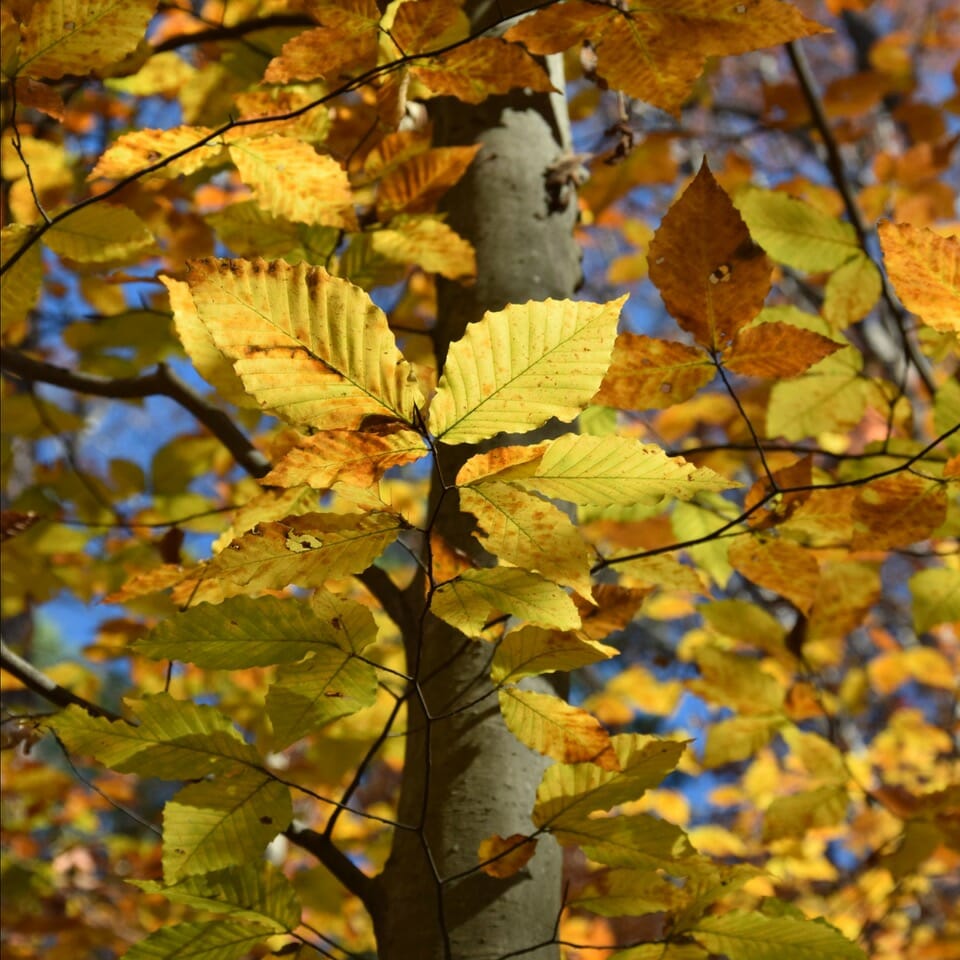2022 Plant of the Year: American beech

The Georgia Native Plant Society’s 2022 Plant of the Year, American beech (Fagus grandifolia), is a shade tree of imposing proportions. A forest-dwelling beech will grow tall, with few lower limbs and a narrow canopy. But a tree grown in the open will swell its trunk and stretch its limbs low and wide, achieving a crown spread almost equal to its height. Georgia’s current state champion American beech, located in Lawrenceville (Gwinnett County), is an impressive 115’ tall, with a crown spread of 91’.
The species is deciduous. In winter, pointy, narrow, reddish-brown leaf buds extend about ¾” from the branch termini; lateral buds are slightly smaller. In spring, emerging leaves appear tassel-like before opening fully. Mature leaves are simple, alternate, ovoid or elliptical, about 3-5” long and half as wide, having parallel veins and leaf margins with incurved teeth. Summer leaves darken gradually from medium to deep green on top, with pale undersides. They turn a lovely tawny yellow in autumn, and then dry to a golden beige. Beech trees hold onto their dry leaves long after other deciduous species have dropped theirs. With their long buds and golden leaves rustling in the breeze, even small saplings are easy to spot in the winter woods.
Individual beech trees have both male flowers (small, pale-yellow catkins) and tiny, paired female flowers. In autumn, the latter are succeeded by three-sided nuts enclosed within spiny, yellow-brown, dime-sized burrs. Nut production runs in cycles, with heavy fruiting every 2-3 years. Beech nuts are highly nutritious. Animals feed on them, and humans can eat them, too. However, they should be roasted if consumed in large amounts, since raw beech nuts can be mildly toxic. (Just an aside—Beech-nut baby food doesn’t contain beech nuts; the brand was named for the beech trees that grew near the company’s original factory).
The most iconic characteristic of the American beech is its smooth, pale gray bark. The bark seems to beguile romantic souls, who can’t resist carving hearts and initials into the living canvases of aged beech trunks. Unfortunately, carving opens wounds that are vulnerable to disease and infestation. While many beeches have survived human scarring, it’s a practice that should be avoided, particularly as trees become stressed by more severe climate variations and an ever-growing array of pathogens.
Two intriguing parasites are dependent upon American beech, neither of which is fatal to the plant. The first is the beech blight aphid (Grylloprociphilus imbricator). Nymphs colonize beech twigs and branches, secreting dense white fluff and stringy filaments over their rear half. Sometimes called “boogie-woogie” aphids, they will lift and waggle their abdomens in synch when disturbed. You can try shaking their twig, but be forewarned—they bite. They also secrete honeydew. A large colony will deposit a sticky puddle beneath an infested branch—not a good place to park your car [1].
The second parasite is beechdrop (Epifagus virginiana). An annual species without chlorophyll, this peculiar wildflower draws sustenance from the roots of its beech host, but takes too little nutrition or fluid to do any harm. Beechdrops flower in autumn. White, tubular, chasmogamous (opening when mature) flowers emerge near the upper ends of upright stalks. Inconspicuous, cleistogamous (non-opening and self-pollinating) flowers appear lower down. After the flowers go to seed, the brown stalks remain in place, and are easy to identify in fall and winter.
American beech trees are important ecologically and economically. Beech saplings are shade-tolerant, making beech saplings a key element of the forest understory. The species is host to a great many moths, beetles, and other insects. Beech nuts provide winter mast for many birds and small animals. Beech timber, known for its straight grain and pliability when steamed, has numerous uses in construction, carpentry, container production, and barrel-making. In addition, beech leaves and bark may be of value medicinally. Native Americans utilized them to treat a number of ailments, including lung ailments, gum disease, and worms [2].
American beech typically grows in upland forests and near wetland edges. It is a gorgeous and stately ornamental species to plant—just don’t expect it to shade your yard anytime soon. Beech grows very slowly. Install it for its autumn foliage and attractive bark, and let future generations enjoy its grand canopy.
Text by Valerie Boss. Photos by Ellen Honeycutt.
[1] James Baker, “Beech Blight Aphid,” PDIC Factsheets, NC State Extension publications.
[2] ” American beech: native American use,” University of Vermont Digital Exhibits.


